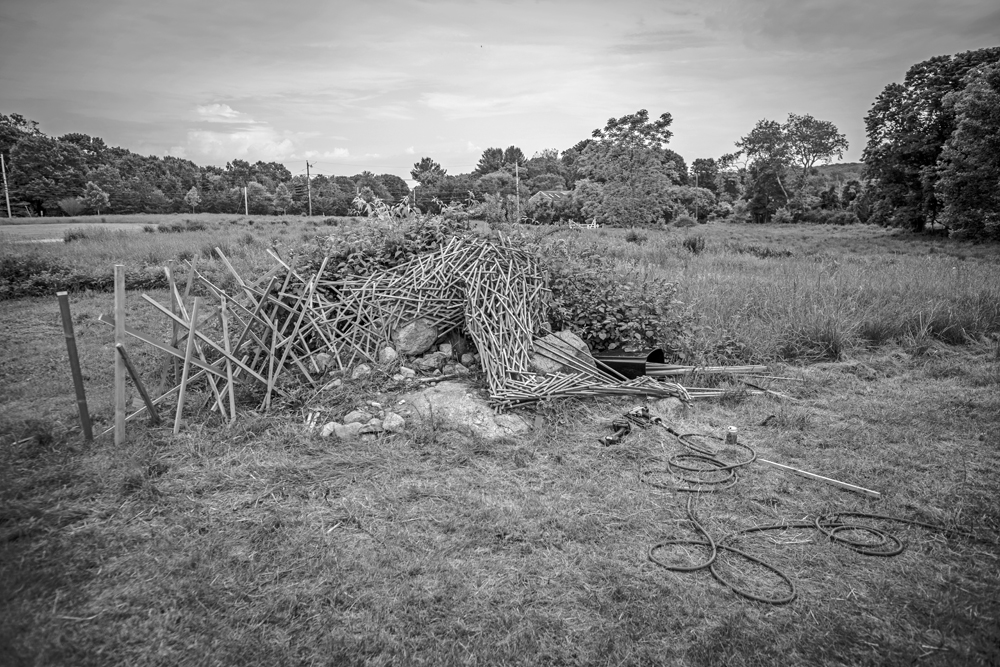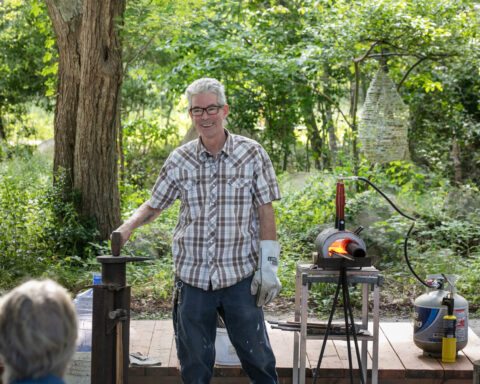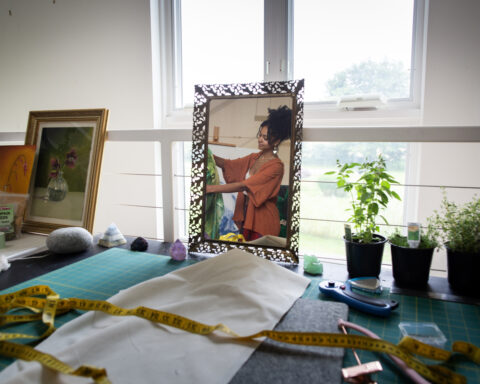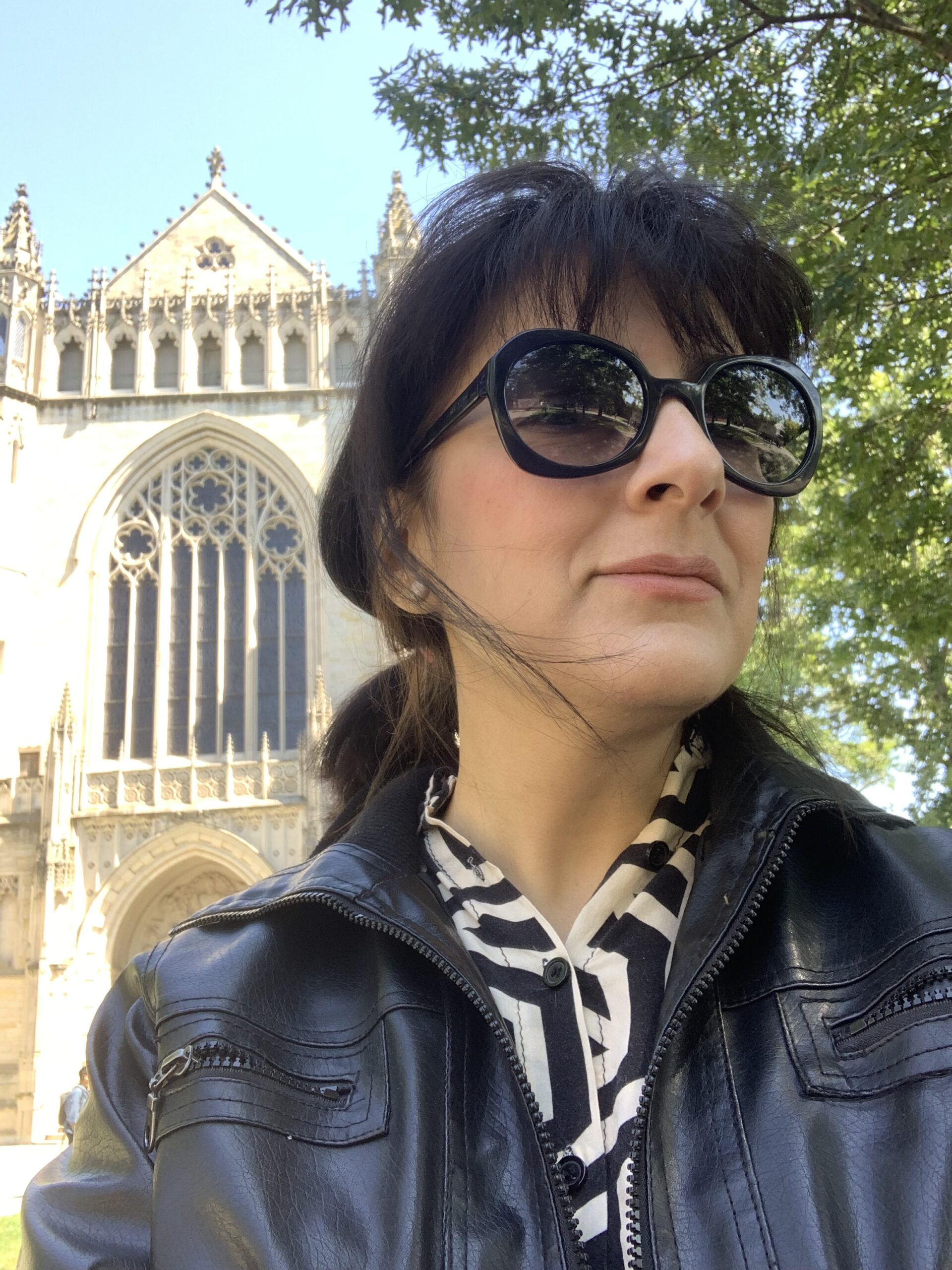I first came upon the energetic wooden sculpture of an exploding man at my friends yoga studio in New Bedford when I was using it as a set for a photo shoot I was doing for South Coast Magazine. As curator of The Westport Artist in Residence Program at the Westport Land Conservation Trust on Adamsville Road, I was in search of a sculptor for the coming Spring. When I saw Rob’s piece, I really loved the high energy of the standing figure reaching and dissolving upwards. The figure in Juliet’s studio had been created for his thesis a decade prior. I reached out to him and found he was an art professor at Eastern in Connecticut.

Trained as a sculptor, Mr. Greene discovered installation art as a masters candidate at UMass/Dartmouth. While his formal training is in figure modeling and drawing, his love of working with wood comes from the trades and working on wooden boats. Below is his interview I did with him during his June 2024 residency.
Merri Cyr: When did you understand that you wanted to pursue art as a career? How did that lead you to teaching?
Rob Greene: In college as an undergrad at Eastern [Connecticut University] I had a professor who took the time to take me aside to tell me that I had the talent to do something in this field.
After college, I worked at a marina in Connecticut for a long time and there came a point where I realized I needed to be doing something else. My body was getting beaten up and I thought it was time to move on. I was accepted to UMass/Dartmouth for grad school and began to find my voice as an artist.
During my time at UMass I had the opportunity to teach. I was terrified because I wasn’t much older than the students, but I had a really great experience. I thought, “Hey, my former professor was a great influence on me, and she loves her job, you know?” I thought, “This is the path I want to follow.” I was awarded a position as a sabbatical replacement, then went into adjunct professorship and then full time—back where that professor first gave me the boost I needed!

Merri: When I look at your work, I see very traditional fine art practices.
Rob: Yeah. Figure modeling and drawing are so heavy in my background as a sculptor, as well as working in clay on the armature to render different poses–while simultaneously learning about anatomy. You learn what works and what doesn’t work, and then translate that into stone. At UMass, I had a professor that really ingrained that.
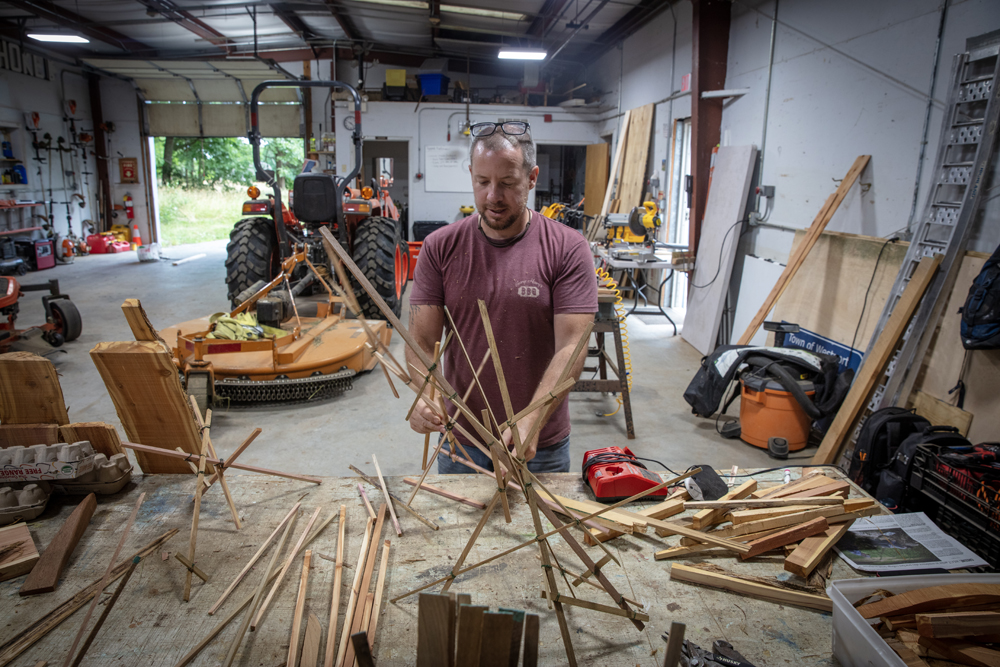
I break the figure down into planes and separate it into forms that are flat and then build them up. For instance, the way a thigh is built up into several planes rather than one just round form. I think when you’re working with clay and building it up and making those planes real you learn to add and subtract. When you’re working in stone, you’re looking for the form of the piece inside and emphasize those planes.
I guess that’s what I’m trying to get at is the underlying gesture of the piece. It may be interacting with another figure or something in nature. It’s a push-pull. If you are here, are the forms going out? If you’re out there, are they coming in? I will explore this concept with the piece I create at Westport Woods.

Works that I really love are traditional forms like a drastic reclining female: a jutting rib cage, almost as if the bone was unnatural and morphed into the stone. It is sort of like thinking about cubism when you’re using smaller blocks to build a quintessential portrait of a figure. I break the figure up into really simple forms and shapes. Shapes on shapes. If those planes get overly built up, it’s overkill. Once you’ve put them in the piece you can go back and soften them. You’re finding these shapes and smoothing them. You keep the planes flowing in a super gestural and fresh way until it’s refined.
In grad school I teach figure modeling using a traditional mallet and chisel. It’s not ephemeral in nature–it becomes an assemblage. That is a voice I didn’t find until college. I was really inspired by the drawings of Alberto Giacometti, with all of the cross-sections and the frenetic energy.
Merri: Besides Giacometti, what other artists were you drawn to?
Rob: I was looking at site-specific artists like Andy Goldsworthy, as well as David Nash, who was working in wood. Antony Gormley works in steel and his works are frenetic but in very solid ways.
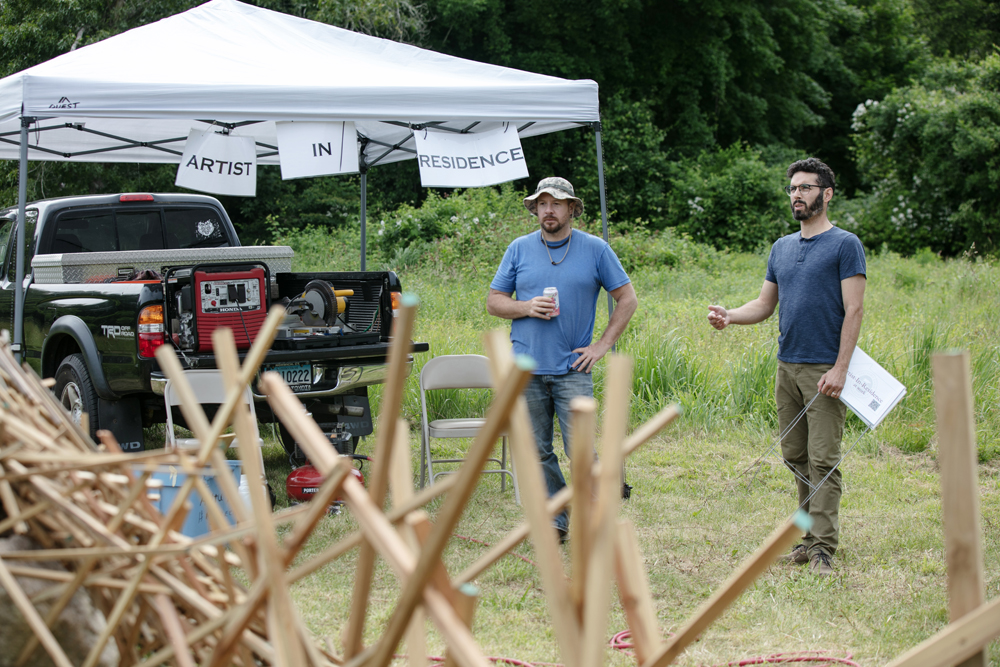
For me it’s always figurative. I have since expanded my concept of what figurative is, which some people might disagree with in a traditional background. But what does figurative mean? Does it mean it has to have anatomically correct proportions or even anything human to it? I think it’s like a sculptural interpretation of my thought, where it’s figurative as well as about the human condition. I still push and play with that. Some things I might consider figurative. Somebody else may see a figure or none at all.
Professor Eric Lintala at UMass/Dartmouth got me to really think about the figure. He saw the figure in so many things: in nature, trees, everything. He could pick out aspects of an object and call it figurative in many ways. We went on different field trips where most people were like, how is that figurative?

The aha! moment for me in school was when I made a work which was an interpretation of my favorite painting from Duchamp: Nude Descending a Staircase. A simple blending of forms, simply figurative, gestural, not cubism but cubic forms blending together. I was so inspired by that I wanted to recreate it in a really frenetic, crazy way with lines, not blocks, and make it out of wood. Turning a painting into a sculpture and recreating it in my own vision, I started out with a form that was just wisps of wood that slowly formed it into a figure. Moving with the staircase, the figures hips shift and the shoulder is moving and there are arms blending. I’m trying to capture it in one movement within the sculpture. I remember getting critiqued on that. And I remember one faculty member saying that I was crazy for reinterpreting a master’s work. But I’ll tell you it sold and I loved it.
It was that sculpture in grad school where I knew I really wanted to work with variation of line–where the lines all come together to create a form playing with a density of movement.

Merri: How did wood become such a primary material for you?
Rob: Growing up and working on wooden boats, I found that wood was just my material. I went from working on wooden boats to working with wood in sculpture. My first job right out of high school was working in a marina. And I learned the art really, of what they called work. I was just varnishing high end boats for high end customers there and I learned what varnishing really means: the building of the layers and the the maintenance and upkeep as well as the beauty of a well varnished boat.
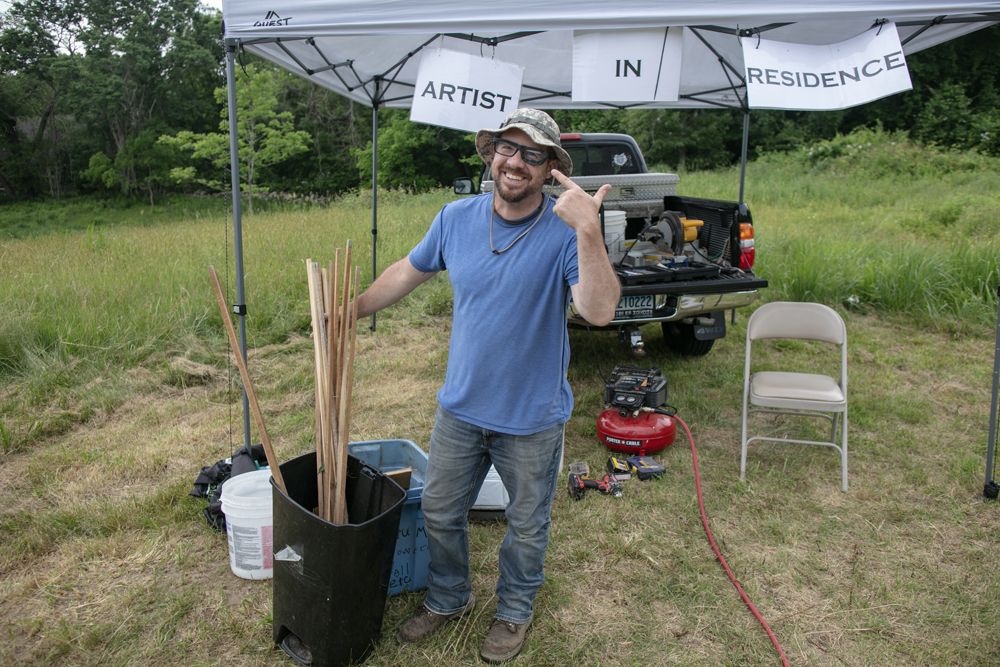
My dad had passed early, when I was 17 and I didn’t know how to do anything. He had been good with his hands. My grandfather helped raise me and he was a woodworker and taught me very traditional building techniques old school style using plumb bobs and hand planes. He taught me how to build. He always he had a stash of harvested teak from boats, or from God knows where, which he would cut up and make things out of. My grandfather taught me how to survive while we lived in a cottage that was falling apart and had taught both my dad and I everything we knew. He worked and prided himself on exact measurements using a micrometer, so working with him on some of his old properties was maddening. I mean, getting down to the hair with a hand plain! It was like do-or-die, you know? Without him, I would only know half the stuff I’ve done. A lot of friends also helped along the way to keep the house from falling in the lake.
I often work with teak: understanding the properties of it, what it does and how it grays out fast in the sun. Teak grows out of water so it doesn’t really rot for many years. It’s a weather resistant wood similar to cedar. But it’s hard to come by real teak now and it’s really a very expensive material. One of the things that contributed to my use was my grandfather’s obsession with it. In grad school a local guy had donated a hangar full of teak where he stored his airplane. The one condition was we had we had to truck it in ourselves. Myself and another student brought back tons of it to the school. That’s the stash I still have now. I’m careful about how I use it because getting it now is impossible.

Merri: Your work often embodies a lot of energy. Do you think when you’re working that you enter into a particular state?
Rob: Yeah. Yes, I can. A lot of times people say you just go into the studio and you’ll make something. You just have to get into the groove. I’ll tell you, if I don’t have it that day, I don’t have it. There are days where I really have to sit and look and step back and then come back with the energy and the vision. And then all of a sudden it just comes out, comes out fast, you know, and you get into a mode and forget to eat sometimes. You forget where your hand is and you shoot the nail, which I’ve done because you’re moving so fast and because you’ve really got to work in that moment. You have to have all of the pieces precut and ready to grab, to assemble, and to create this figure that is anatomically understandable with just the right line in just the right place. It seems simple, but there’s a complexity to it. At the beginning it’s building the form. Towards the end, it really comes down to just the right piece in just the right place. So, there’s intuitiveness. Creating the figure with the material at hand and being in the mode.
It takes energy to do the kind of work that I do. It’s physical and also a requires a lot of the prep work which takes a fair amount of time. Cutting the sizes, the right lengths, having enough ready because you don’t want to stop in the middle and have to start cutting again.
You prepare all the materials and that allows you to get into the zone. If you stop, you lose your momentum. You get energy through the cutting and repetition, which in its own way becomes a cathartic experience.

Merri: Can you describe how you move through working on a piece? How would you break that down?
Rob: First you have the vision. I start with concept sketches and just a strip of teak. It starts with one and then another one and then another one. You build this rough outline from the middle out, and depending on how dense you want it to, you can build it very light and airy with longer pieces or very tight. There are many layers and a density to it, but it all starts with these single pieces that basically becomes a gestural rough sketch.
If you’re doing something human or figurative or the gesture is in the hips, how many layers are you going to need to actually create it? So yeah, I guess you just have to start from square one, and really just build up from there. That’s the hardest part is getting to that. If it’s not right, it’s just like an armature under the clay and it’s not going to look right. At that point you might have to pull apart several pieces and rethink it to get it right.

The way I work is like a drawing, working with line and assembling quickly. For me there’s a sense of intuitiveness that just goes hand in hand with doing the work. If it doesn’t look right, I pull that away and move it just a little bit and boom, quick brad nail and I move on. It’s like drawing with a piece of charcoal on the paper with layers. My work is so different from the way my grandfather would have taught, but he loved it and was super proud of the work that I was making because it was just so beautiful to him, you know?

Thom Filicia, the decorator and interior designer turned media star and brand, imagined his room as an elegant semi-public office and library, pointedly eschewing bookshelves. “Why have something you’re not going to utilize?” he said. The teak sculpture by Robert Greene is called “Frenetic Composure.” (Image and caption excerpted from article in the New York Times)
The Artist in Residence program would not be possible without funding from the Westport Cultural Council and the Helen K. Ellis Trust Grant, administered by the Bank of America. Thank you for supporting public art!
